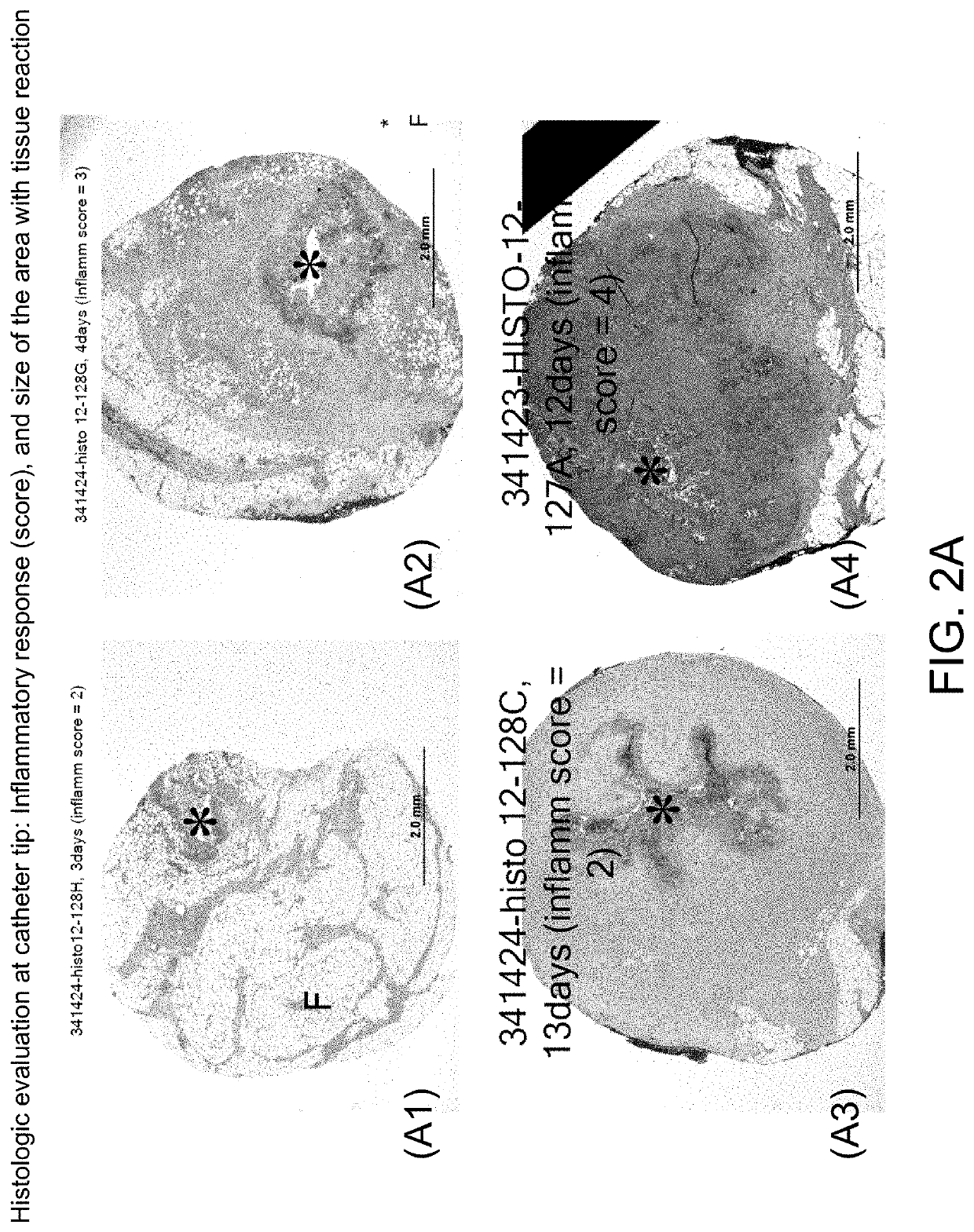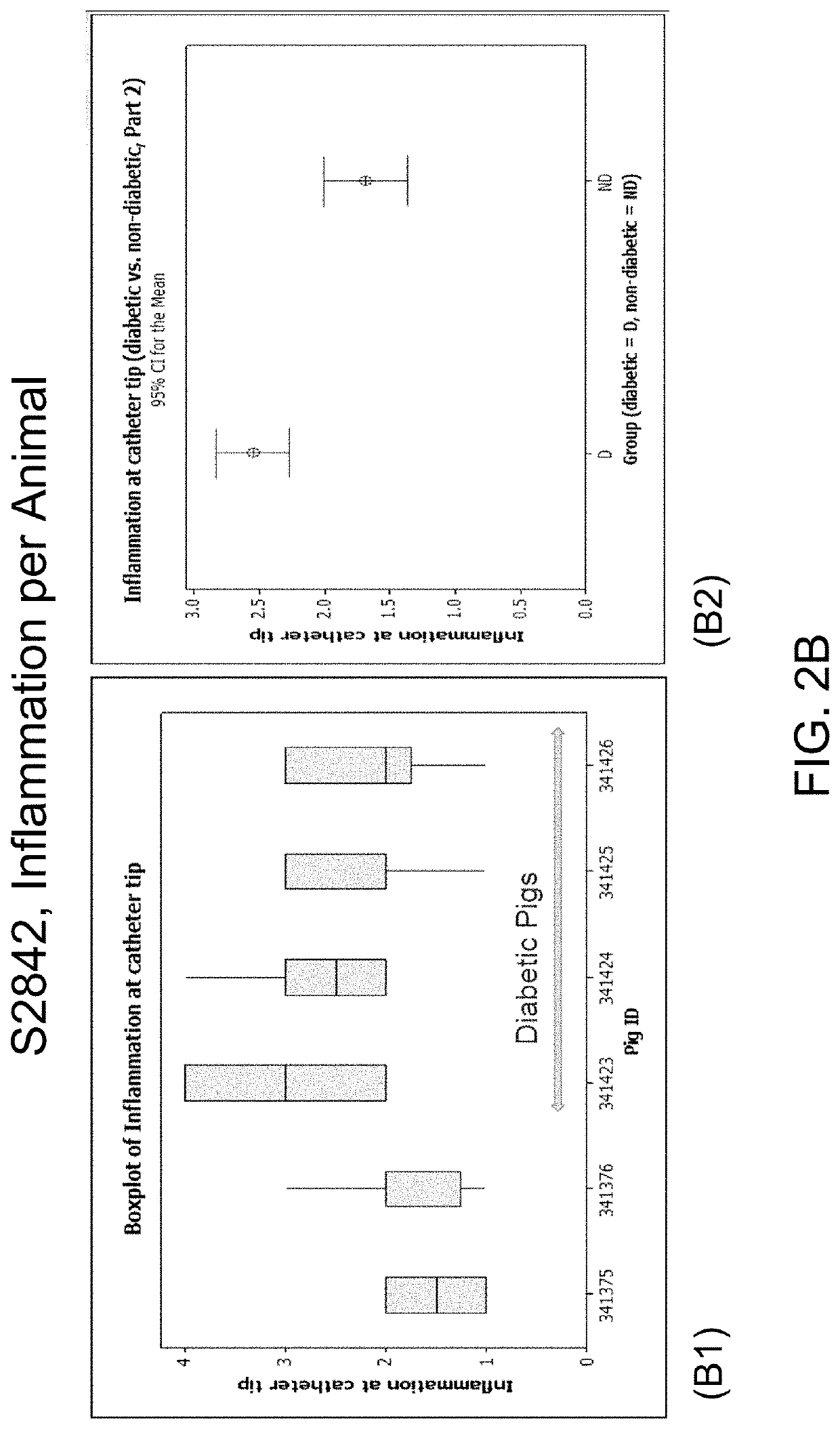Methods and systems for inhibiting foreign-body responses in diabetic patients
a diabetic patient and foreign body technology, applied in the field of methods and systems for inhibiting human foreign body responses to implanted medical devices, can solve the problems of affecting the treatment effect of diabetic patients
- Summary
- Abstract
- Description
- Claims
- Application Information
AI Technical Summary
Benefits of technology
Problems solved by technology
Method used
Image
Examples
example 1
ding the Site-Loss Mechanism Using Animal Models
[0100]Causes of site reduction are poorly understood and can be due to localized inflammation or tissue proliferation. Understanding the cause through a time-based biopsy study allows for development of infusion sets that could be extended beyond three days, hence improving patient comfort and compliance. A diabetic animal model that shows site reduction 2-10 days after placement of transdermal insulin pumps is used so that the local tissue response to continuous subcutaneous insulin infusion (CSII) can be studied by in-situ skin biopsies.
[0101]FIG. 1 is an illustration of an exemplary medical device used for diabetes management which includes a fluid path schematic of an insulin pump. An illustrative infusion set comprises a three-layer tubing of polyethylene (PE), ethylene vinyl acetate (EVA), and polyvinyl chloride (PVC). The catheter material may be Teflon™ or stainless steel.
[0102]Continuous subcutaneous insulin infusion (CSII) is...
example 2
sive Patch
[0116]Table 5 shows examples of steroids, immunosuppressant drugs, cox inhibitors, non-steroidal anti-inflammatory drugs (NSAIDS), and anti-proliferative agents that can be blended in an adhesive and / or penetrant to achieve an anti-inflammatory effect.
[0117]
TABLE 5DrugDrug TypeAdhesivePenetrantDiclofenacAnti-inflammatory; NonsteroidDuro-Tak 387-2287,Isopropyl palmitate,CelecoxibAnti-inflammatory; NonsteroidDuro-Tak 87-2287,IPM (Isopropyl Myristate),RofecoxibAnti-inflammatory; NonsteroidDuro-Tak 87-4287,Lauryl lactate,NaproxenAnti-inflammatory; NonsteroidDuro-Tak 87-2074Triacetin,PiroxicamAnti-inflammatory; NonsteroidSorbitan oleateRapamycinImmunosuppression, Anti-proliferativeSpan ® 80 nonionic surfactant,(Sirolimus)Propylene Glycol,Triacetin
[0118]As shown for example in FIG. 3, a transdermal patch is a medicated adhesive patch that can be placed on the skin for several days depending on the skin type. The medication can penetrate the skin to reduce the inflammation at the...
example 3
ed Cannula
[0119]A subcutaneous infusion set normally includes an insertion needle, which is assembled with the soft cannula and is adapted to pierce the patient's skin for transcutaneous cannula placement. The insertion needle is thereafter withdrawn to leave the cannula in place for subcutaneous fluid infusion. Although the materials used for the cannula are typically flexible enough to provide comfort for the patient, the inevitable movement of the cannula that occurs as a patient moves results in inflammation. Where a needle is inserted for cannula placement, an injury is created. The implanted cannula, a foreign body, elicits an exacerbated host response, while greater inflammation occurs as a result of any cannula movement. The situation may be even worse for the hard cannula, which may be the reason why the hard cannula infusion sets have a recommended use-life of 2 days.
[0120]A process / mechanism is also provided for reducing coagulation, inflammation, reducing / inhibiting scar...
PUM
| Property | Measurement | Unit |
|---|---|---|
| time | aaaaa | aaaaa |
| time | aaaaa | aaaaa |
| concentration | aaaaa | aaaaa |
Abstract
Description
Claims
Application Information
 Login to view more
Login to view more - R&D Engineer
- R&D Manager
- IP Professional
- Industry Leading Data Capabilities
- Powerful AI technology
- Patent DNA Extraction
Browse by: Latest US Patents, China's latest patents, Technical Efficacy Thesaurus, Application Domain, Technology Topic.
© 2024 PatSnap. All rights reserved.Legal|Privacy policy|Modern Slavery Act Transparency Statement|Sitemap



